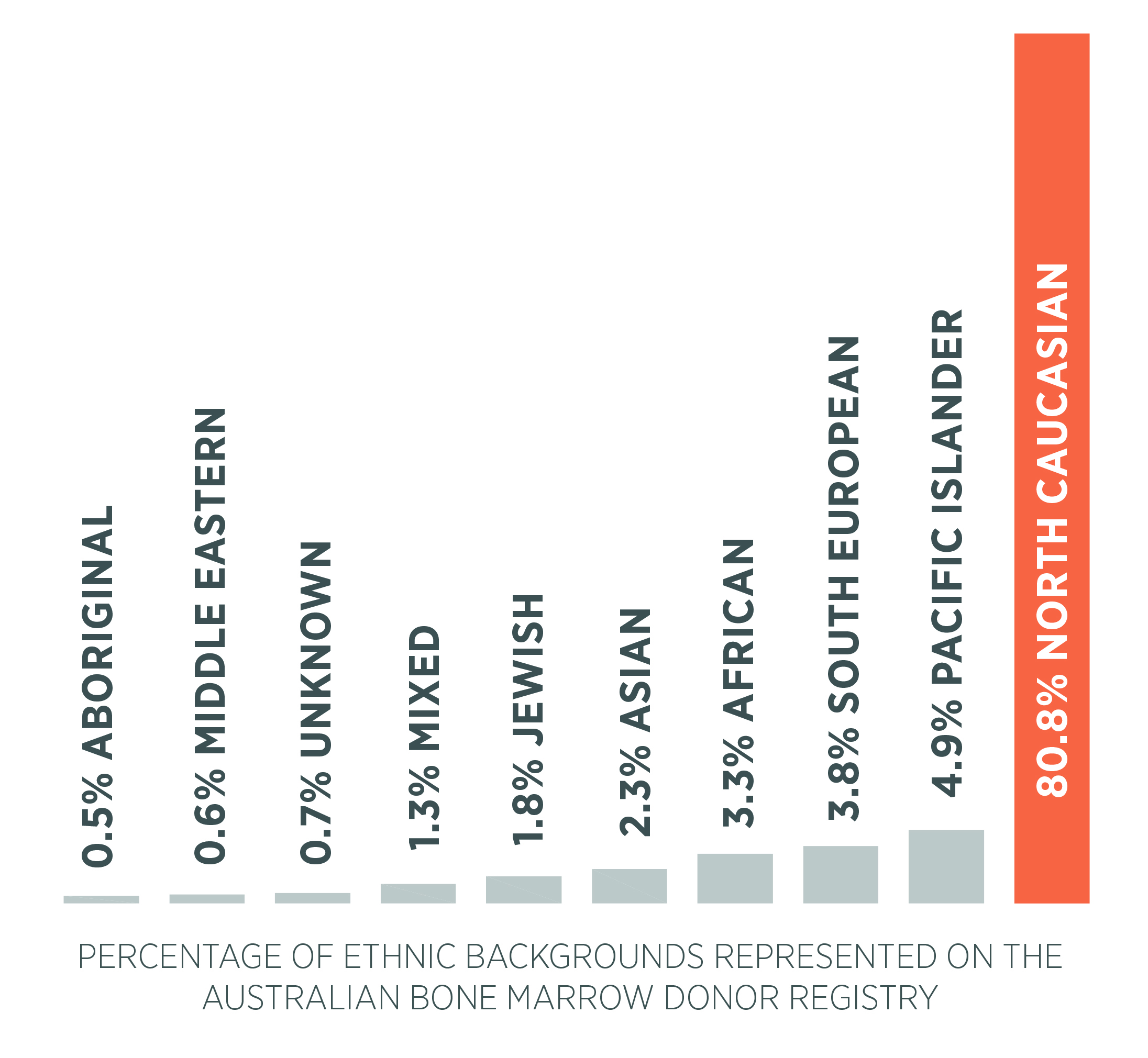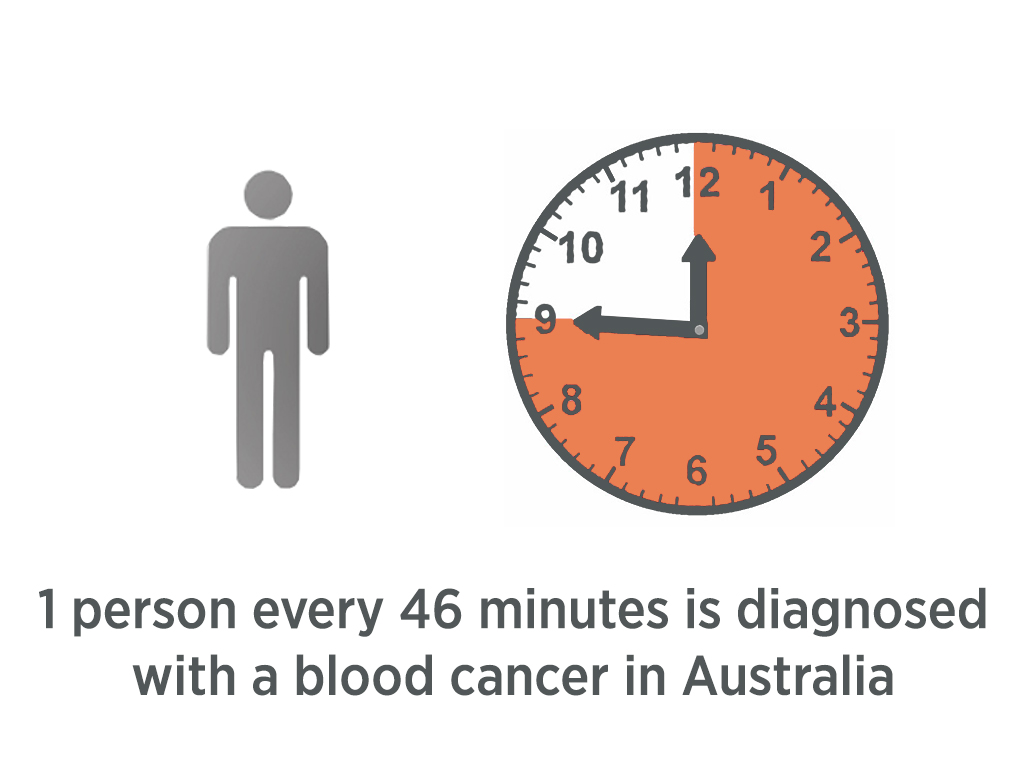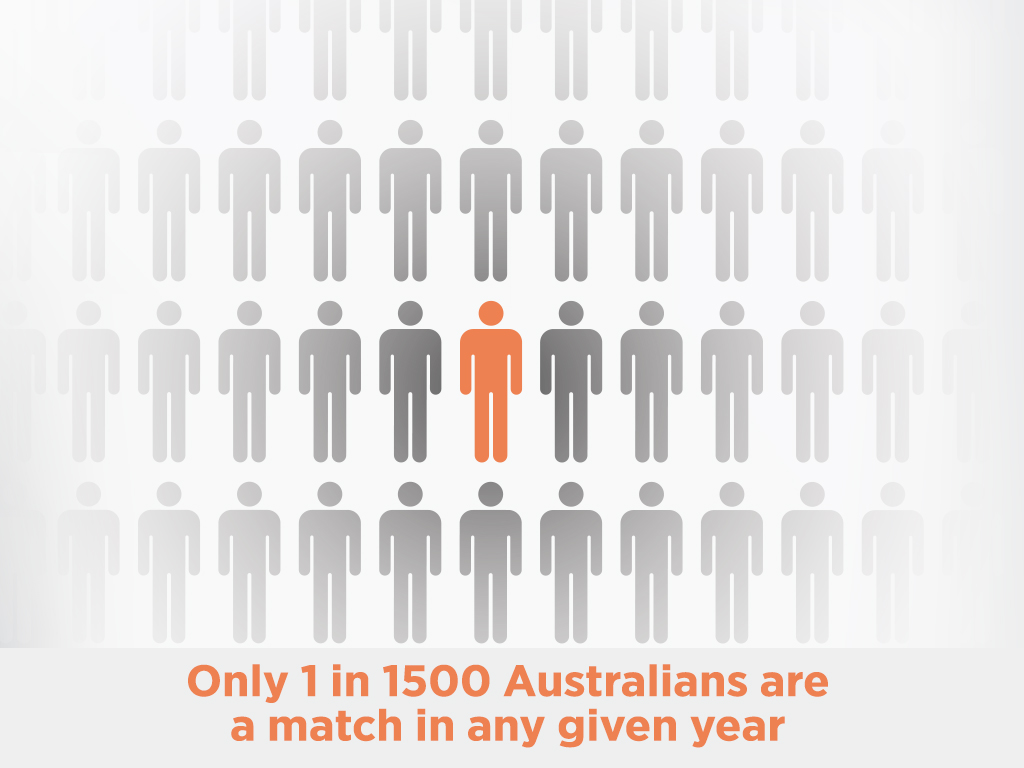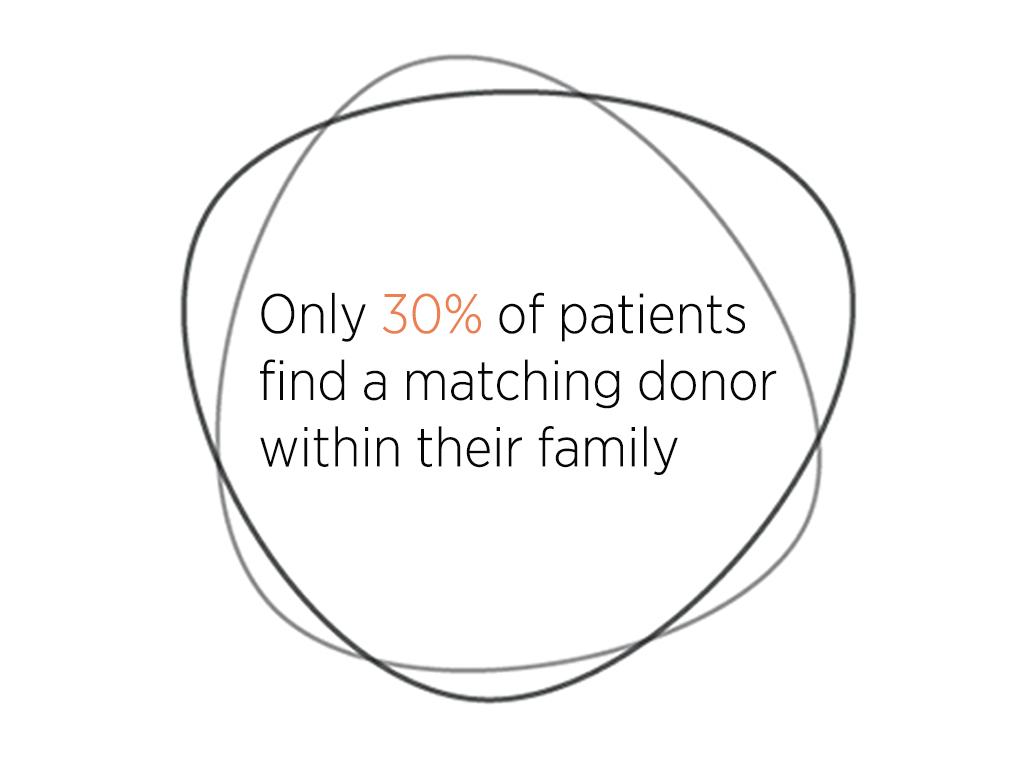Common Questions
See below for frequently asked questions or you can download our Common Questions fact sheet here.
QUESTIONS ABOUT JOINING
-
There are 2 ways you can join the blood stem cell donor registry, by completing a mouth cheek swab or through a blood donation.
Option 1 - Mouth cheek swab
The simplest and easiest way to join is through a simple mouth cheek swab! Order your cheek swab kit online at www.urthecure.com.au/swab
You will receive your kit in the mail with easy step-by-step instructions. Simply use the included swabs (they are similar to a cotton q-tip) to swab the inside of your mouth to get the saliva sample, then post it back. That’s it! Your sample will be added to The Registry to be made searchable and potentially matched with a patient in need!
Option 2 - Blood donation
Alternatively another way you can join is by donating blood at Red Cross Lifeblood. If you’re a blood donor aged 18-35, you’re eligible to join Australia’s blood stem cell donor registry. Click here to sign up (note you will be re-directed to our partner’s website at Strength to Give to register). At your blood donation appointment let the staff know that you wish to join the Australian Bone Marrow Donor Registry and they will take a small blood sample. Please be aware that the eligibility for donating blood is different and generally more strict than the eligibility to join The Registry. If you are not eligible to donate blood, then please consider joining through a cheek swab.
To find your nearest Red Cross Lifeblood donor centre visit www.donateblood.com.au (on the website you can enter your post code and your nearest centre details will be displayed including a map).
-
If you are between the ages of 18-30 then you are in the ideal age bracket to become a donor, but you are still able to register to be a donor up until the age of 35. You’ll also need to be willing to donate, anonymously, to any patient in Australia or overseas and hold a valid Medicare card (please be aware that you do not have to actually travel overseas when donating to an overseas patient, it can all be done locally in Australia)
You’ll also need to be able to answer “NO” to the following questions:
Have you ever been diagnosed with thalassaemia major
Have you ever received an organ or bone marrow transplant?
Have you ever suffered a stroke or heart attack?
Have you ever had a positive test for HTLV or HIV?
There are also a few conditions that may or may not affect your eligibility. If you’ve ever suffered from any of the following conditions please contact our partner at info@strengthtogive.org.au.
Cancer of any kind (except basal cell carcinoma of the skin or squamous cell carcinoma (SCC) of the skin)
Pre-cancerous conditions, such as cervical abnormalities
Auto-immune diseases (except minor conditions like psoriasis or vitiligo)
Please be aware that there is extra eligibility criteria on top of what is mentioned above for joining through the Red Cross Blood service (blood donation eligibility). If you are not eligible to donate blood, then please consider joining through a cheek swab.
-
It's great that you are already a blood donor and you may also be donating other blood products like plasma! However this does not mean that you are automatically added to the stem cell/bone marrow registry. You need to specifically request to join the registry, you will need to register to join beforehand and let the staff know at the Red Cross Lifeblood centre that you would like to join the stem cell donor registry.
-
There is no cost to join the registry.
-
No you do not need to do a cheek swab if you have already joined the registry in the past through a blood donation, this would result in a duplicate registration.
-
When you join the registry a sample of your DNA will be collected to determine your “HLA” – human leukocyte antigen. This is essentially your unique “code” which is cross-referenced with all the searching patient’s “codes” to see if you are match. No identifying information is stored, only your “code”.
-
Your saliva sample is not stored anywhere and it is destroyed after it has been tested, the only thing that remains is your HLA tissue type “code” with no identifying information.
-
Strength to Give and the Australian Bone Marrow Donor Registry recognise the importance of respecting your privacy and protecting the confidentiality of you and your family’s personal and health information. They collect this information to ensure safe matching of potential donors and to maintain the quality of the registry database. They work closely with the Australian Red Cross Blood Service (Red Cross Lifeblood) and a network of health professionals and partner organisations, including registries in other countries. They do not provide information that would identify you to persons outside The Registry, The Blood Service or the health professionals involved in your care.
If you are identified as a potential match your name will never be shared with the patient or their treating team. The information provided to other registries and treating doctors is solely to enable them to confirm your suitability as a match. If the match is confirmed and you agree to donate, only the hospital and health professionals involved in the collection process will know your identity. The Registry’s full privacy policy can be viewed here.
-
Yes it safe. You can order your kit online and return your completed kit by placing it in a post box without any contact with anyone. Only complete the cheek swab if you are feeling well.
Note that we especially need people to join during this challenging time. 80% of Australian blood cancer patients receive their lifesaving stem cells from an overseas donor, with the corona virus outbreak and border restrictions, this is a challenge. We need more local Australians to join!
-
No! No matter your sexual orientation or identity, you are welcome to join through a mouth cheek swab.
QUESTIONS ABOUT WHO WE NEED TO JOIN
-
Nobody likes to hear that they are “too old” in any circumstance! But in the case of stem cell donation, there is scientific evidence that younger stem cells perform better in a transplant which means a higher chance for a successful outcome for the patient. Younger stem cells basically perform better in a transplant which means less complications and a better chance of survival for the patient.
Also in the next year there will be 30,000 people retiring off The Registry so we really need young people to join!
-
Some people wonder why we don’t encourage everyone to join regardless of their cultural or indigenous heritage.
It’s amazing that everyone wants to help and in an ideal world we could have anyone and everyone join! We already know that a patient is more likely to find their stem cell match with someone who shares a similar ethnic or indigenous background to them, and we know that these groups are underrepresented on the registry which means these patients are often the ones who struggle to find their match.
If we were to DOUBLE the number of people currently on the registry as it is, it would only increase the chances of overall matching by 5%....and that’s because it’s heavily skewed to representing people with a North Caucasian (“white”) background.
Also with limited funding and a limited number of samples that can be collected each year, people joining who have a North Caucasian background essentially uses up funding to test a sample type that we already have plenty of and doesn’t necessarily increase overall matching. So it becomes even more important to make sure the “right” type of samples are collected which are those with any sort of ethnic or indigenous heritage. Learn more about ethnicity here.
-
Males physically have more stem cells to give plus biologically don’t have to worry about pregnancy or breastfeeding that can get in the way of donating!
QUESTIONS ABOUT DONATING YOUR STEM CELLS
-
Only 1 in 1500 Australians will get called to donate their bone marrow/stem cells in any given year. In fact some people go their whole life without getting the call. So don't be expecting calls every few months or even years to donate your stem cells! It’s important to always keep your contact details up to date. And when registering, choose an emergency contact who will likely be around for a long time like a sibling rather than an older relative for example. This makes it easier to track you down if needed!
-
One of the most common misconceptions is that donating stem cells is extremely painful! Thankfully this is not the case!
If you are someone's match, the most common way to donate your stem cells is through PBSC (Peripheral Blood Stem Cell) donation which is a non-surgical procedure. This is done 90% of the time. It is similar to donating blood or plasma, you may experience some discomfort while the needles are in your arms, but there is no pain associated with the procedure itself. You can often watch TV or read a book during the procedure whilst reclined in the chair or relaxing in a bed! Any other short term symptoms that you may experience are mild (such as headaches and flu like symptoms) and can be relieved with paracetamol such as Panadol. They usually disappear after collection. Find out more about PBSC donation.
If you are in the small percentage of people who need to do a bone marrow donation, you will be placed under general anaesthetic so you will not feel any pain during the procedure. This is done 10% of the time. A needle and syringe is placed into the pelvic bone cavity at the back of the hip to withdraw bone marrow. You may feel a dull ache at the base of your back near your pelvic bone afterwards and this can be relieved with paracetamol like Panadol. These aches will fade away usually within a few days.
If you are asked to donate your bone marrow in this way, then it’s likely the patient receiving your bone marrow is a baby or child. So although it requires more effort, it makes your experience extra special knowing you can save a child’s life! Find out more about bone marrow donation.
-
If you are donating through PBSC donation (most common method), the procedure takes approximately 3 to 4 hours to perform.
If you are donating through a bone marrow donation (less common method), the procedure can take about 1 to 2 hours to complete, this can either be done as a day-stay or as an overnight stay.
Both methods require some of your time beforehand to fill in forms and questionnaires and to have some routine tests done.
-
If you are doing a PBSC donation (most common method), you can usually return straight to work and continue on with normal activities.
If you are doing a bone marrow donation (less common method), you can usually go home the same day or you may need to stay overnight. The aches that you may feel afterwards can take a few days to disappear.
-
Your health is very important and your medical team will never put you through a procedure if they believe you are not healthy or fit enough, all the necessary checks are done beforehand. If you are doing a bone marrow donation (less common method), there are the usual risks associated with being placed under general anaesthetic or having surgery. The chances of a serious complication is very low.
There has been a lot of research into donor health and there are no long term side effects for stem cell donation. Doctors will never risk one person's health in order to help someone else, they care about the health of both the donor and the patient.
-
If you are doing a PBSC donation (most common method), a special drug is given to you in the lead up to your donation which stimulates the bone marrow and produces more stem cells. It is these excess stem cells that are donated, so you actually do not lose any stem cells.
If you are doing a bone marrow donation (less common method), then your body will replenish the bone marrow usually within 4 weeks.
-
There is no cost to you as the donor. Only your time and commitment.
-
Although we know that almost everyone would be happy and proud at the chance to save another person's life, it is important to know that when you receive that first call saying you may be someone’s match you still have the opportunity to pull out. You are obligated to donate further along the process when the patient receives the high dose chemotherapy. From this point there is “no going back”, because if someone pulled out at that point, the patient would die without the stem cells to re-build their immune system. Do not take your decision to join the registry lightly. You need to be prepared to show a level of commitment when you join as it is not fair for patients to receive false hope.
-
No. Although you may be inspired by a friend or family member who is searching for their match to join, you can’t ask to be specifically tested for a loved one who is sick (unless you are a sibling). When you join the registry you can potentially be matched with anyone, anywhere around the world.
The chances of you matching with your loved one and also a complete stranger is extremely low. So don’t worry, in the unlikely event that you are the match for your loved then you will be called!
It’s much more likely that if you match anyone, it’ll be someone you don’t know, maybe even someone living overseas.
-
If you match with a patient overseas this does not mean you need to travel to that country. You can donate your stem cells locally in Australia and they will be transported overseas.
Stem cell donation occurs in most of the main cities in each State around Australia (except the Northern Territory). Travel expenses incurred to travel within Australia for a stem cell donation are reimbursed, they’ll even cover the costs to bring a support person with you! Think of it as a free domestic holiday!
-
If you are matched with a patient and asked to donate your stem cells, your health and safety are very well protected. Unwell people are not allowed to donate until they have fully recovered. Donating stem cells will not make you weak or reduce your immunity. All the necessary health checks and tests are done beforehand and an independent specialist will assess you medically. Donor health is taken very seriously, so you can be sure you can save a life without risks to your own health!
Only 1 in 1500 Australians are a match in any given year and asked to donated their stem cells
Learn about the 2 different ways you can donate your blood stem cells
Learn about the donor selection process
OTHER QUESTIONS
-
No your blood type does not need to match the patient's blood type. It is the other markers in the blood that are more important for matching, in some cases the patient will even have a new blood type (your blood type) after the transplant!
-
There are lots of different markers in the blood that will determine if someone is your match or not. Your ethnic background plays an important role when looking at all of these markers and you are more likely to match someone who has a similar ethnicity or cultural background to you. Your blood can be what’s called “tissue typed” to find out what its unique “code” is and this is what’s compared to the patient’s “tissue type” or "code” to see if there is a match. If the cells are not matched then they will attack the patient's body because they detect the organs as foreign and the patient would die - transplants are never done unless the right match has been found.
-
These different terms can cause confusion and are sometimes used interchangeably. In the past the phrase “Bone Marrow Transplant” was commonly used. Nowadays you may hear it being called a “Stem Cell Transplant” (which is the abbreviated version of "Peripheral Blood Stem Cell Transplant" or “PBSCT”).
This is because of improvements in technology and development of drugs that can safely cause the stem cells to come out of the bone marrow and into the peripheral blood circulation/stream that can be collected and used for transplant (see PBSC Donation for more information). Traditionally the only way to have these cells taken was directly through the bone marrow and that's why it was called a "Bone Marrow Transplant".
So a peripheral blood stem cell transplant - PBSCT or stem cell transplant) - or a stem cell donation, is when the stem cells have been collected from the blood stream. Whereas a bone marrow transplant (BMT) - or bone marrow donation, is when the stem cells have been collected directly from the bone marrow.
Stem cells can also be collected from an umbilical cord, all these cells are virtually the same but have been collected in different ways. Most people will describe it as either a bone marrow or stem cell transplant/donation.
This is also why you hear the registry being referred to using different terms; the bone marrow registry or the blood stem cell registry or just stem cell registry!
Learn more about the donation journey - from the patient requiring a stem cell transplant to how a suitable donor is found and matched
Your blood type does not need to match the patient’s blood type!
HOW DO STEM CELLS CURE CANCER?
Stem cells are the building blocks needed to create a new immune system
Stem cells are the building blocks of the body. The stem cells from our bone marrow make up our immune system including white cells. These cells play an important role in our bodies including fighting off infections and disease.
A new immune system can kill the cancer
A person with blood cancer does not have a normal functioning immune system because it is allowing the cancer to live in their body. The idea of receiving someone else’s stem cells means that a new immune system can be formed which will hopefully detect the cancer and kill it. The stem cells can also be used to cure many other blood disorders and immunodeficiencies.
What's involved for the patient?
The cancer patient will receive high dose chemotherapy that wipes out their own immune system so they will have zero white cells. The stem cells from a healthy person (the donor) is then given so they find their way into the patient’s bone marrow to re-build a new immune system and fight the cancer. Many people think that it’s a big operation or surgery for the patient receiving the transplant, but in fact the actual receiving of the stem cells is quite uneventful and similar to receiving a blood transfusion! It’s the days and weeks after receiving the transplant that pose the biggest risk. After the transplant, a patient is given a combination of different drugs to help balance the effects of “graft vs host” disease. The donor’s cells will detect the patient’s cells as foreign and attack, but this needs to be balanced with the drugs. You want some level of attack to happen as this is what essentially kills the cancer! But too much attack can have a deadly effect on the patient. Over the weeks after the transplant, doctors do tests on the patient to assess what percentage of the cells are theirs versus the donor cells. The first 100 days after the transplant is critical for the patient, whilst their immune system is rebuilding itself they can become susceptible to infections, even the common cold can be deadly. The 100 days is a big milestone and the percentage risk of major complications decreases after this point. Eventually the patient adopts their donor’s immune system. It is a long road to recovery and sometimes a lifetime of managing the long term side effects, but eventually many patients can go on to live a long and healthy life, all thanks to the incredible generosity of their donor who saved their life!
Interesting Facts
1 person every 46 minutes is diagnosed with a blood cancer in Australia.
Right now there are 1000 patients in Australia searching for their lifesaving match
There are over 110,000 people of all ages living with a blood cancer today in Australia. For many of them, a stem cell transplant can be their only chance for a cure
Only 30% of patients searching for their life-saving match will find it within their family. 70% need to find an unrelated donor through the Australian or worldwide Donor Registries.
Over 80% of potential donors on the Australian Bone Marrow Donor Registry are of North Caucasian background. There are not enough people with a culturally diverse or indigenous background on The Registry which means patients with a diverse background will almost always struggle to find their lifesaving match.
Young males are the ideal donor although only 4% of donors on the registry are males aged 18-30.
All the individual registries in each separate country are inter-connected worldwide so a Doctor can search the whole world for their patient's match.
80% of Australian patients receive their stem cells from an overseas donor. We need more local Australians to join the local donor registry. Relying on overseas countries for our supply of stem cells is not ideal and at times can add extra complexities (the COVID-19 pandemic has highlighted this even more so).
After receiving a stem cell transplant a patient’s blood type can change! Their immune system and blood type will be replaced with their donors immune system. This also means that the patient has a brand new immune system and has to have all the same vaccinations that baby’s receive after they are born!







